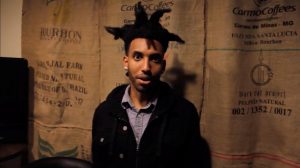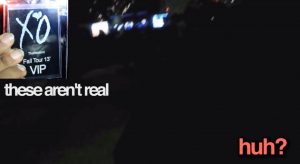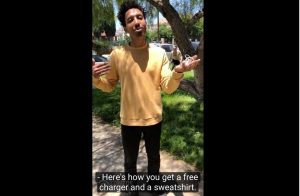This interview has been edited for clarity and length. For the full interview:
cstonline.netstefaniamarghitu.com/2019/01/18/creating-content-for-social-media-tv-an-interview-with-biniam-bizuneh/
29-year-old Indianapolis native and LA-based comedian Biniam Bizuneh created, wrote, produced and starred in one of the first Comedy Central ventures into what is now often referred to as “Social Media Television”: his satirical lifestyle How-To series How To Be Broke.
This interview traces Bizuneh’s career as a comedy creator of his own work, focusing on his understanding of how content on social media is produced and distributed for viewers. This marks a new type of showrunner in the digital post-network era. Like many showrunners, Bizuneh used both his creative talent and industry knowledge to navigate his own project. Bizuneh’s How To Be Broke draws on medium specificity of Youtube, Snapchat and social media content that directly addresses the audience.
SM: You moved to LA in 2012, how did your career start out here?
BB: I came almost right after graduating college. I tweeted something about not getting an internship at Funny or Die after I got really far in the process and it fell through; it was this really bad joke, I don’t even remember what it said. Then someone who I knew from stand up in Indiana, Chad Quandt, responded that his workplace Maker Studios had internships, so I ended up there. I also worked at Pac Sun at the Grove, and at a call center. The internship eventually turned into a job, so I stayed and kept doing comedy.
SM: What did the job at Maker Studios entail?
BB: I was a “manger of comedy Youtubers.” It was a job that never existed before and I was just making it up as I went along. They [the Youtube comedians] were almost like test subjects. I was learning about how to put stuff online, and the best ways for it to be something that people will want to watch and share.
SM: What kind of material were you putting online during that time?
In college, I made videos where I pretended to be a British exchange student and interviewed people about things like the “North Face” epidemic taking over campus, as if it were an actual plague. I loved doing that sort of stuff. I saw that unscripted material did a lot better than sketches on Youtube, and I wanted to make something that would get attention so I could get representation and start writing for TV, [and so on]. I started a series called Lie Guys, which was basically doing my version of Nathan for You: a very hip-hop, black culture focused Nathan For You.
SM: I see a bit of The Ali G Show in it too! I think there’s a trajectory from that to Nathan For You too.
BB: Totally. I love The Ali G Show. I would set up these premises and speak to the camera like, “I look [like rapper] The Weekend, and he’s Ethiopian, and so am I, so I’m going to dress up like him and go to this concert and see if people think I’m him.” I just walked in. And I would re-create the story in post [production] with my voiceover and editing. I’d make it look like it went really well and edit out what didn’t really work for the narrative.
SM: And there’s probably an economy of it. You mention these types of videos did better than sketches. I imagine they are inherently cheaper to make as well. Was that a factor?
BB: Oh yeah. I decided to do that series based on my limitations, and what I thought would do well on the Internet. I treated it like a season of TV where I made and edited six or seven of them and showed them at live comedy shows. Then I edited them again based on what got laughs. I released them on Youtube every two weeks for three or four months. It gained a little following, something like 35,000 subscribers.
And that was enough to get a manager to take note of what I was doing. So from that I started getting opportunities. I consulted for Billy on the Street, which was cool, that was my first job like that. And then I got a lot of little other things. Comedy Central actually saw a lot of these videos, these Lie Guys things. So I met with them, and they said, if I ever have an idea to make something, to let them know. That was sometime in 2015.
SM: Can you talk about how you came up with How To Be Broke?
I had the idea for the series in 2017, and it was based on this whole genre of Youtube How-To Videos. Some of them would be so silly and fake and contrived. So I thought this could be a scripted format parody where we use the “How-To” as a framing device. Because I love when shows do that. Like Review on Comedy Central, where you’re pretending to do a format of a reality type show, but it’s all scripted and more about the characters themselves.
And I started thinking what could be the funniest character to do this? It should be someone who is completely incompetent about it. They don’t really understand the consequences, they don’t think anything through. It’s just someone trying to get followers, and do whatever thing he can do that he thinks people will watch. So the idea was for it to seem like this guy was making it on his own Snapchat. And that limitation was cool, because in each Snapchat, there’s only ten seconds.
I knew Comedy Central were looking for Snapchat shows. So I pitched that idea to them, and they were receptive.
If you watch the series, you wouldn’t really think of it, but we had a whole crew.
We had sound, a director, extras, a PA, craft services, lighting, a truck for a generator. And there’s a lot of people who see it and say “That’s cool they let you make it on your own.” It’s funny, to make something scripted look real, it takes a lot more than you would think, because you have to get all the details right, even if you’re trying to do this found footage look.
SM: The actual medium seems critical for making the right content.
BB: That was something I learned from Maker Studios. Broadcast or cable outlets cable would make this content on their Youtube channels that looked like TV or film quality, and they spent a lot of money on it, but it had no views. And they always asked, “why isn’t this working? This is the best looking stuff!”
And the problem was making stuff for the wrong medium. Youtube has its own identity, and people are going to Youtube for a different reason than going to watch TV. So the content for Youtube should be tailored to those needs. If you’re going to a movie or to watch a TV show, you go to forget you exist.
You go to Youtube to have a friend. The fourth wall is constantly being broken, and that’s the content that does the best. So when I was doing the Lie Guys thing, I wanted to start each video with me speaking directly to the camera.
And Snapchat is a medium where people are usually opening it and talking straight into it. And I could make it scripted, but make it look like your friend doing a video on his own.
SM: And everyday folks and celebrities are already doing that kind of lifestyle, how-to thing. That’s totally brilliant. The Kardashians promote things and show people how to use them. You have vloggers and makeup tutorials. Even this Marie Kondo How To Be Tidy series, I mean that’s a different format but the same kind of concept.
BB: Yeah, it’s an educational “here’s how to make your life better” kind of thing. When I was first making it, I had to fight for some of those things. Instead of putting up a minute and 30 seconds long video that has all of the Snaps as one video, it should be each individual snap as its own thing so it feels like real Snapchat story, rather than a video. I wanted to integrate with the platform.
https://youtube.com/watch?v=DYq9_27y-YA
SM: And for the second season, things changed?
BB: Yeah, Comedy Central stopped their relationship with Snapchat and told us we didn’t have to be limited to 10 second videos. We could still use the format– and I wanted to make sure it stayed vertical because that’s how people watch things on their phone. And so, we made each story beat longer, but they were at the longest maybe 20 seconds. We got more of a budget and made the stories a little crazier, and it released as 2-3 minute videos on Instagram TV, Facebook and Youtube. It was the fist content Comedy Central came out with for Instagram TV.
SM: Is there going to be a Season 3 of How To Be Broke?
BB: We might do another season if the ideas come together and it feels like something new. I was just really adamant about only doing it if it was good, and not feeling like it was a step backwards.
SM: It’s a good move to have that freedom too. Series can end on a high note now when the creators want.
BB: Yeah, I’m trying to figure out if there is a linear scripted TV version.
SM: And is that the ultimate goal, to be on your own show on Comedy Central or a similar platform?
BB: Yeah, I would say the goal is to make something you know a lot of people can see and enjoy, but also having the freedom to make something exactly what you want. When you have a TV show, you have the budgets and staff involved that can create the kind of vision you want. So I like that aspect. That’s even more important to me than whether it’s a TV show or on the Internet even. Because now, people watch things anywhere. It’s more about the budgets.
SM: The work you are doing seems to be a new trajectory of content creators. Even if a lot of showrunners like Donald Glover or Issa Rae started with Youtube , then to a more traditional platform on cable or streaming, do you identify with them?
BB: I definitely look at people like Donald Glover and Issa Rae and find inspiration in making my own stuff. And it’s similar in that I made my own thing, and got paid to do my own thing. It’s definitely at a lower level, a digital, small budget show.
But it definitely comes from the idea that you can’t wait around for anyone else to make a thing for you, or give you an opportunity; you have to create your own opportunity.
SM: Within the industry, a lot of times, you can have a good showrunner but a show they create or want to star in will never air. But they can do someone else’s show.
BB: And a lot of creators don’t have the ability to do what they do. The organization skills or the leadership.
SM: If you had a project, and say it went straight to series, as a creator, would you work with someone like that?
BB: We’ve had conversations like that, but nothing really stuck. But yeah, I think whether its Broad City and Amy Poehler producing it and bringing the prestige factor, or with Larry Wilmore and Issa Rae. If I was ever in a position like that, if I had a pitch, and I thought it was good, I think that my representation could hook me up with someone who would like it and increase value, and I would totally be open to that.
Stefania Marghitu is a PhD candidate and Annenberg Fellow with the University of Southern California’s School of Cinematic Arts Division of Cinema and Media Studies. Her primary interests deal with critical and cultural studies of television, the showrunner and modes of authorship, production cultures, and feminist media studies. Her dissertation project is titled The Showrunner: Authorship, Identity Politics and Representation in US Television. She will be releasing her first book, co-authored with Ellen Seiter, entitled Introduction to Teen Television with Routledge in 2019. You can also find her work in Feminist Media Studies, Communication, Culture and Critique, The Spectator and the edited collection ReFocus on Amy Heckerling (Edinburgh University Press).










